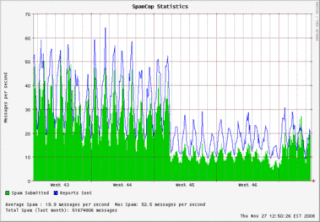Related Research Articles
A bomb threat or bomb scare is a threat, usually verbal or written, to detonate an explosive or incendiary device to cause property damage, death, injuries, and/or incite fear, whether or not such a device actually exists.

Extortion is the practice of obtaining benefit through coercion. In most jurisdictions it is likely to constitute a criminal offence; the bulk of this article deals with such cases. Robbery is the simplest and most common form of extortion, although making unfounded threats in order to obtain an unfair business advantage is also a form of extortion.
Various anti-spam techniques are used to prevent email spam.

Phishing is a form of social engineering and a scam where attackers deceive people into revealing sensitive information or installing malware such as viruses, worms, adware, or ransomware. Phishing attacks have become increasingly sophisticated and often transparently mirror the site being targeted, allowing the attacker to observe everything while the victim navigates the site, and transverses any additional security boundaries with the victim. As of 2020, it is the most common type of cybercrime, with the FBI's Internet Crime Complaint Center reporting more incidents of phishing than any other type of cybercrime.

Email spam, also referred to as junk email, spam mail, or simply spam, is unsolicited messages sent in bulk by email (spamming). The name comes from a Monty Python sketch in which the name of the canned pork product Spam is ubiquitous, unavoidable, and repetitive. Email spam has steadily grown since the early 1990s, and by 2014 was estimated to account for around 90% of total email traffic.

Yahoo! Mail is an email service offered by the American company Yahoo, Inc. The service is free for personal use, with an optional monthly fee for additional features. Business email was previously available with the Yahoo! Small Business brand, before it transitioned to Verizon Small Business Essentials in early 2022. Launched on October 8, 1997, as of January 2020, Yahoo! Mail has 225 million users.

Bulletproof hosting (BPH) is technical infrastructure service provided by an Internet hosting service that is resilient to complaints of illicit activities, which serves criminal actors as a basic building block for streamlining various cyberattacks. BPH providers allow online gambling, illegal pornography, botnet command and control servers, spam, copyrighted materials, hate speech and misinformation, despite takedown court orders and law enforcement subpoenas, allowing such material in their acceptable use policies.

Blue Frog was a freely-licensed anti-spam tool produced by Blue Security Inc. and operated as part of a community-based system which tried to persuade spammers to remove community members' addresses from their mailing lists by automating the complaint process for each user as spam is received. Blue Security maintained these addresses in a hashed form in a Do Not Intrude Registry, and spammers could use free tools to clean their lists. The tool was discontinued in 2006.
On Internet usage, an email bomb is a form of net abuse that sends large volumes of email to an address to overflow the mailbox, overwhelm the server where the email address is hosted in a denial-of-service attack or as a smoke screen to distract the attention from important email messages indicating a security breach.
Internet safety, also known as online safety, cyber safety and electronic safety (e-safety), refers to the policies, practices and processes that reduce the harms to people that are enabled by the (mis)use of information technology.

Swatting is a criminal harassment act of deceiving an emergency service into sending a police or emergency service response team to another person's address. This is triggered by false reporting of a serious law enforcement emergency, such as a bomb threat, domestic violence, murder, hostage situation, or a false report of a mental health emergency, such as reporting that a person is suicidal or homicidal and may be armed, among other things.

Proofpoint, Inc. is an American enterprise cybersecurity company based in Sunnyvale, California that provides software as a service and products for email security, identity threat defense, data loss prevention, electronic discovery, and email archiving.

McColo was a US-based web hosting service provider that was, for a long time, the source of the majority of spam-sending activities for the entire world. In late 2008, the company was shut down by two upstream providers, Global Crossing and Hurricane Electric, because a significant amount of malware and botnets had been trafficking from the McColo servers.

Sextortion employs non-physical forms of coercion to extort sexual favors from the victim. Sextortion refers to the broad category of sexual exploitation in which abuse of power is the means of coercion, as well as to the category of sexual exploitation in which threatened release of sexual images or information is the means of coercion.
Social spam is unwanted spam content appearing on social networking services, social bookmarking sites, and any website with user-generated content. It can be manifested in many ways, including bulk messages, profanity, insults, hate speech, malicious links, fraudulent reviews, fake friends, and personally identifiable information.
The Kelihos botnet, also known as Hlux, is a botnet mainly involved in spamming and the theft of bitcoins.
The CryptoLocker ransomware attack was a cyberattack using the CryptoLocker ransomware that occurred from 5 September 2013 to late May 2014. The attack utilized a trojan that targeted computers running on Microsoft Windows, and was believed to have first been posted to the Internet on 5 September 2013. It propagated via infected email attachments, and via an existing Gameover ZeuS botnet. When activated, the malware encrypted certain types of files stored on local and mounted network drives using RSA public-key cryptography, with the private key stored only on the malware's control servers. The malware then displayed a message which offered to decrypt the data if a payment was made by a stated deadline, and it threatened to delete the private key if the deadline passes. If the deadline was not met, the malware offered to decrypt data via an online service provided by the malware's operators, for a significantly higher price in bitcoin. There was no guarantee that payment would release the encrypted content.

GameOver ZeuS (GOZ), also known as peer-to-peer (P2P) ZeuS, ZeuS3, and GoZeus, is a Trojan horse developed by Russian cybercriminal Evgeniy Bogachev. Created in 2011 as a successor to Jabber Zeus, another project of Bogachev's, the malware is notorious for its usage in bank fraud resulting in damages of approximately $100 million and being the main vehicle through which the CryptoLocker ransomware attack was conducted, resulting in millions of dollars of losses. At the peak of its activity in 2012 and 2013, between 500,000 and 1 million computers were infected with GameOver ZeuS.
On the evening of December 6, 2018 at approximately 10:15 pm Eastern Standard Time, the Time Warner Center in New York City was evacuated due to a bomb threat by a phone call from an unknown source. The building houses CNN offices and studios for most of its American shows, and the live broadcast of CNN Tonight was interrupted when a fire alarm went off and employees had to exit the building. Host Don Lemon tweeted the happenings as the broadcast suddenly ended and a previously taped Anderson Cooper 360 program aired in its place. Shortly after, Lemon, along with media analyst Brian Stelter and crime and justice reporter Shimon Prokupecz continued a live broadcast from the outside of the building, providing updates to the bomb threats. Police did not find any suspicious devices and the suspect was not identified.
Starting in late April 2024, numerous bomb threat hoax emails and calls were received by many establishments including schools, colleges, hotels and airports across India, most of which were targeted at organisations in Delhi.
References
- ↑ Cleary, Tom (December 13, 2018). "Bitcoin Bomb Threat Emails Spark Evacuations Nationwide". Heavy.com. Retrieved December 13, 2018.
- ↑ Groch, Dan Jervis-Bardy, Sherryn (December 14, 2018). "Bomb threat forces school evacuations across Canberra". Canberra Times. Retrieved December 15, 2018.
{{cite web}}: CS1 maint: multiple names: authors list (link) - ↑ Robertson, Adi (December 13, 2018). "Bitcoin scammers send bomb threats across US, causing evacuations". The Verge. Retrieved December 13, 2018.
- ↑ Cimpanu, Catalin (December 13, 2018). "'Bomb threat' scammers are now threatening to throw acid on victims". ZDNet. Retrieved January 28, 2019.
- ↑ Krebs, Brian (January 22, 2019). "Bomb Threat, Sextortion Spammers Abused Weakness at GoDaddy.com". Krebs on Security. Retrieved January 28, 2019.
- ↑ Johnson, Tim (January 23, 2019). "Those bomb hoaxes last month? GoDaddy may have played unwitting role". McClatchy Washington Bureau. Retrieved January 28, 2019.